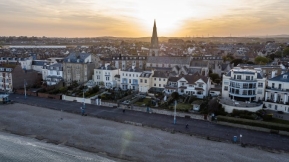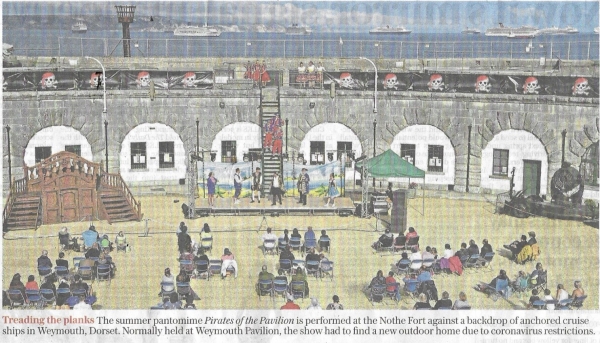Exeat: Day 150/84: Weymouth basks in Gerorgian fame and more
Why all the new found focus? It has to be the cruise liners basking in the Bay gratis that's got dozens of photographers sending in shots to the media; but even BBC 6pm News carried the tale that the tourists are taking boat trips from the harbour to cruise around the cruise liners. It's got to be a short step surely before one of the more enterprising franchises out its lounge area for afternoon teas on board. Or is it the work of our own new Weymouth Town Council since April 2020 - really a gigantic parish council within new unitary Dorset Council covering the entire west of the old county. Wherever the credit lies the media have earlier this month dubbed Weymouth one of the few remaining great seaside towns … right of course! And Good Hanoverian King George III, who may have lost the American Colonies and worse, must be eternally proud that he discovered the merits of the town long ago* as his statue and his bathing hut attest. The royal title Regis is seldom seen today because it is attached to Melcombe, the area to the east of the river which includes where the King lodged on his visits; today the combined community is better known as Weymouth.
 

It was Julian and Laura that suggested Weymouth should be the end of Avril's south coast search for a beach home. They are there again this week!. They'd been with their lads as toddlers to a caravan park at Preston end of town; and as soon as we visited we loved it and Somerset House was just being refashioned from its old Greenhills Hotel into four apartments and a private house. We loved the 'Somerset' connection and immediately grabbed the Duke's Arms for the foyer and tracked His Grace himself out to his lands just north of Totnes - of blessed WW2 memory in the Seymour [yes, the Duke's family name] Hotel there. We were fascinated by his ancestors where Jane Seymour had, as wife to Henry VIII, given birth to King Edward VI. And it was Jane's brother who as Lord Protector of England had defeated the Scots at Pinkie Cleugh in 1547 in a vain attempt to persuade Mary, Queen of Scots, to marry Edward VI. Today's Duke eventually joined our re-enactments in Musselburgh/ Pinkie in 2017.

Talking of photographic stringers, the picture above has it all … the Summer panto transferred to Nothe Fort and the seven ocean liners in the backdrop. Mathew was there with his family twice in the last month alone …

… and there too is Richard Drax MP [left] whose ancestors were amongst those successfully plotting the overthrow of King James II in 1686/88 …. with the incomparable Rees-Mogg whose father, William, then Editor of The Times in the 1960s gave Ronald Yearsley and I a break with Scientific Business/ Management Decision and the eventual foundation of emerald publishing house today. Small world; only connect; what goes around comes around …. [pictures from today's Daily Telegraph.]
___________________________________________________________________
*Rachel Knowles summarises the story of King George III's love of Weymouth abstracting from Weymouth Bay from Weymouth and Melcombe Regis: New Guide by E Groves (1835) and other local histories.
A superior seaside resort. In November 1788, George III became mentally unstable precipitating the Regency crisis but just as George, Prince of Wales, was about to take power as Regent the King substantially recovered. Dr. Crane, author of Cursory Observations on Sea-Bathing, advocated the benefits of sea air, sea bathing and even seawater drinking as a cure for a wide variety of ailments and was quick to recommend his home town of Weymouth as the best place for the King to convalesce! "Weymouth of late years has been much frequented for its commodious Sea-Bathing which it furnishes in a manner superior to any other in the Kingdom…I do not wonder at its being the Resort of many people of the first Distinction.” The Duke of Gloucester who already owned a house in Weymouth and offered to lend this to his brother for his seaside holiday. Gloucester Lodge was a modest red brick house built sideways onto the Esplanade with a sizeable garden called the Shrubbery. However, it was not big enough to accommodate all the Royal party comfortably and the gentlemen were forced to stay in neighbouring buildings. The King, together with the Queen and his four oldest daughters, arrived in Weymouth at the end of June 1789 to a tremendous welcome. The words “God Save the King” could be seen everywhere – on caps, on windows and even on bathing assistants’ waistbands. The anthem was played often sometimes in the most unlikely places - on one occasion a band hid in a neighbouring bathing machine and struck up the anthem when the King went to bathe in the sea. The people were delighted that the King had recovered and had come to be amongst them and they were determined to let him know. This first visit was a big success. The Queen declared that the King was “much better and stronger for the sea bathing”. Life in Weymouth exactly suited the King and he came back in 1791 and then every year until 1805 except 1793 and 1803. When the King was in Weymouth the government came to him. Pitt visited him here whilst serving as First Lord of the Treasury and it was in Weymouth in 1798 that the King signed papers elevating Admiral Nelson to the peerage.
The daily routine. The King’s routine varied little from day to day. He usually rose early and bathed in the sea and then spent time riding, walking and sailing. The King was able to forgo many of the restrictions imposed on his freedom in London. He was able to walk about freely and talk to his subjects reportedly ending his sentences with the refrain: “What? What?” He particularly liked to talk to local landowners about agriculture, gaining him the nickname “Farmer George”. The King enjoyed going to the theatre where he was perfectly happy with the mediocre entertainments provided. Fanny Burney, one of the King’s party in 1789, was not impressed with these shows, describing them as “in the barn style” – a mere medley of songs, dances and imitations. Sometimes the theatre did manage to secure famous actors such as Mrs Siddons and John Quick to perform for the King. The Royal family visited the Assembly Rooms where balls were held twice a week. The King liked to visit the local landowners. In 1789 he visited Mr Damer at Came House, the Welds at Lulworth Castle and Sherborne Castle, the home of Stephen Digby, one of the King’s equerries. George also loved to sail and frequently went on cruises aboard the warship Southampton often visiting the Isle of Portland. As the war with France progressed an increasing number of army camps sprang up around Weymouth to guard against the threat of invasion and from 1804 these troops were augmented by men from the German Legion.
Published Date: August 19th 2020
|





